
James Comiskey is a horticulturist and award winning garden designer who has just opened a new design studio in my home town of Kilcock. I have had the pleasure of helping James out with one of his show gardens that he entered in to Bloom a number of years ago. James has been running his own very successful landscape design company, About Your Garden, for five years now.
In this new series ‘Meeting Ireland’s Green Fingers’ I am hoping to share and promote some of the fantastic horticultural people that Ireland has to offer. With my interviews I hope to share the advice and knowledge of some like minded green fingered people and ask the hard cutting questions like What is your favourite plant (A hard question for a true plant lover to answer on the spot!!). Below is my interview with James Comiskey.
Meeting Ireland’s Green Fingers – James Comiskey
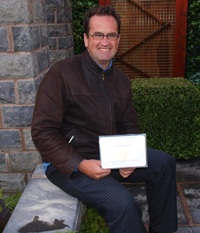
1. What is your earliest memory of gardening or plants?
Planting a Cotoneaster Dammeri with my mother when I was two or three years old. Thirty years later my father retired and decided to tidy up the garden. He took a chainsaw to the plant that had not been pruned in 30 years! Unfortunately the plant did not survive the cosmetic surgery……..
2. Why did you decide to work in the horticulture field?
To be honest I wanted to be a farmer. I really enjoyed working on the family farm as a youngster and I am an outdoors person. Coming from a small family farm with five other siblings I could not see a future in farming. In secondary school art was my best subject and thanks to a brilliant art teacher called Leon Lynch the subject was brought out in me. So I decided to combine my love of art and the outdoors by applying for a place in Landscape Horticulture at University College Dublin.
3. Are you a Grow Your Own or Buy Local? (If a GYO’er what are your favourite things to grow)
I got really sick and stopped growing my own three years ago. Thankfully I am back on my feet and have started growing my own again. You have to grow your own strawberries and peas! There is nothing like a strawberry or pea straight off the plant. I am giving tomatoes a spin this year as I am not doing any shows. You cannot buy a tomato like one straight off the wine. I found in the past I would be gone for a month, and on return my tomatoes would be dead or near death. Hopefully I have more success this year!
4. Describe your approach to gardening in five words
I listen to the client.
5. What is the one tool no gardener should be without and why?
A good set of secateurs. I use them for everything! From cutting rope to opening bags of compost and sometimes pruning. But I do sharpen them regularly.
6. What is the most under-rated plant you think people should use?
Ivy. People look at it as a weed. I have worked for other landscape companies in the past where they have sent me off for a couple of days just pulling it off walls. If you keep it under control it can soften buildings without damaging them. It can form a great back drop in a garden, and is brilliant for wildlife and biodiversity.
7. About Your Garden turned five this year, what changes have you noticed in garden design since it started?
In terms of design a lot of recycling is going on. For example you see pallets being used in all sorts of interesting ways now. I just built a really cool counter in my new studio shop in Kilcock out of pallets, bits of my garden from BBC Gardeners World Live and paving slabs I took out of various gardens over the last five years.
8. Where do you find your main inspiration for designs?
It depends on the project. For example the assumed context for my Silver Gilt garden at BBC Gardeners World was any British or Irish City centre. The materials were borrowed from buildings surrounding the garden. These were concrete derived products, timber and metal. I then had to look at softening the whole garden with the planting scheme. With planting design you start with the conditions, soil type, aspect and prevailing weather conditions and work back from there.
With my first award winning garden at Bloom I was living in a house in Cork that seemed to have a million eyes looking into the garden. I was there for a year and did not really use the garden because there was no privacy. I had a year to think about how I could make the garden private without creating an eyesore for the people looking in. And that is where I came up with the idea for my trademarked pergola.
What I am trying to say is that the inspiration could come from anywhere. With real gardens I start by defining a brief with the client. I then look at the context of the garden. Then I come up with something based on this.
With show gardens I try to push the boundaries. It is my one opportunity of the year to do something in a garden that a client normally would not allow me to do. If I can pull it off then maybe someone will see it and ask me to put it in their garden. I might see something on TV or in a catalogue that makes something click.
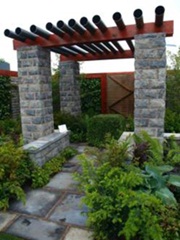
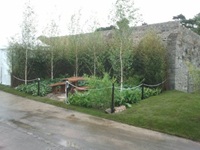
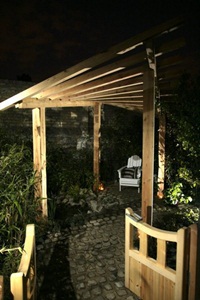
9. You have created show gardens at Bloom and BBC Gardeners’ World Live, what goes into making award winning show gardens?
An awful lot of work! For me coming up with the design is the easiest part. You will start your initial application about eight months in advance. Once the application is submitted to the RHS or to Bloom I will get feedback and may have to tweak the design. You may also need to clarify some aspects of your brief or design.
Funding the garden is hardest part. I have five designs on my hands at the moment that could be accepted for Bloom or a Royal Horticultural Society Show. At this time I am engaging with three potential sponsors. Six months ago I was also engaging with three potential sponsors. I had a garden accepted for Bloom and RHS Tatton this year but the sponsorship did not come together.
Once you get the sponsorship building the garden is one of the most enjoyable and stressful things you will ever do. You are on a very tight timeline that cannot slip but always does. Deliveries will not arrive when they are supposed to, suppliers will let you down, ponds will leak but somehow you always get the garden built! At the end of the show you have to demolish the garden. This generally takes three days.
The amount of time that goes into a show garden depends on the size and complexity of the garden. But all in all you are looking at three months work for a show garden. That is from developing the concept to break down.
10. What is the biggest misconception about show gardens that visitors could have?
That all designers have the same resources to realise their vision. Some designers have more resources at their disposal than others. It is particularly hard starting out as new designers do not have the same resources at their disposal as more established designers. In some way many people think a bigger garden deserves more merit than a small garden. I think someone who can pull off any medal in a small garden with a minuscule budget deserves to be applauded more than someone who wins best in show with a massive budget.
11. What are your top tips for people trying design their own gardens?
Keep it simple, you are not a professional.
Look at what is around you and take inspiration from that. That could be the landscape, streetscape or buildings.
Just because something looked great on a sun holiday it does not mean it will successfully transfer to our rainy climate.
Get advice or do your research before putting plants into your garden. I have seen so many people buy a little plant in a 2 litre pot. Ten or fifteen years later they are paying tree surgeons thousands of euros to remove a monster that has thrown their garden into permanent darkness.
I could go on and on but I think a simple rule of thumb is that whatever you put in your garden should make sense. If you are not sure ask someone else. For example would it make more sense to put the shed against the house instead of at the end of the garden. That way you will not see the shed when you look out the window. But then that raises the question of where to put the patio?
Design is a process and not a series of interventions. Many DIY gardens become a series of interventions with the end product becoming space that is not very nice to be in.
Think out what you want your garden to be firstly, and then make those interventions. Part of the reason why I opened the shop in Kilcock was to allow people to come to me for advice. Feel free to call in any time!
12. What is the one thing that Irish horticulture is missing that you have seen somewhere else? Why would you like to see it here?
I think in Ireland we have many groups promoting and supporting horticulture in their own way. They all do brilliant work in their own right. I don’t think we are as streamlined here as the RHS is. The RHS has a network throughout The UK made up of people from every conceivable background in horticulture. When you have one group with a diverse range skills covering one area things can get completed much more efficiently.
I have to say we are getting better here and there are some brilliant people doing brilliant things. Perhaps as an industry we need to get behind them more. It might be as simple as making an effort to attend a plant sale or helping to promote horticulture rather than just our business.
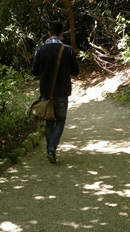
My Name is David Corscadden and I have just finished my degree in horticulture from UCD. I have a keen interest in wildlife friendly gardens or as I like to call them “Wild Gardens”. I have in the last year taken a u-turn in what I thought I would do after college. I have moved more in to the literature side of horticulture and plan to do a masters in journalism next year.
Source: Beyond the Wild Garden – Meeting Ireland’s Green Fingers – James Comiskey – David Corscadden






